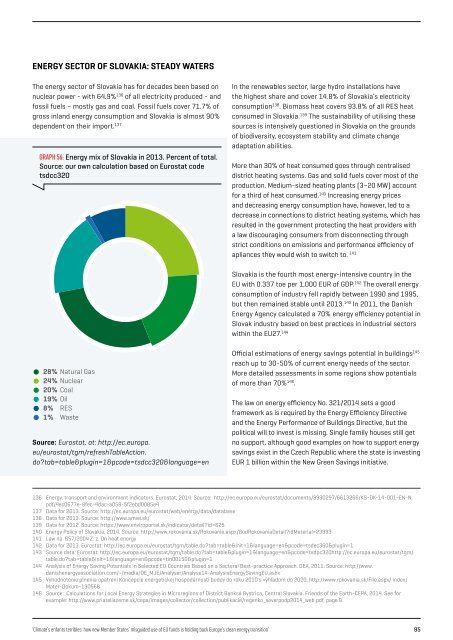ENFANTS TERRIBLES
enfants-terribles
enfants-terribles
You also want an ePaper? Increase the reach of your titles
YUMPU automatically turns print PDFs into web optimized ePapers that Google loves.
ENERGY SECTOR OF SLOVAKIA: STEADY WATERS<br />
The energy sector of Slovakia has for decades been based on<br />
nuclear power - with 64.9% 136 of all electricity produced - and<br />
fossil fuels – mostly gas and coal. Fossil fuels cover 71.7% of<br />
gross inland energy consumption and Slovakia is almost 90%<br />
dependent on their import. 137<br />
GRAPH 56: Energy mix of Slovakia in 2013. Percent of total.<br />
Source: our own calculation based on Eurostat code<br />
tsdcc320<br />
In the renewables sector, large hydro installations have<br />
the highest share and cover 14.8% of Slovakia’s electricity<br />
consumption 138 . Biomass heat covers 93.8% of all RES heat<br />
consumed in Slovakia. 139 The sustainability of utilising these<br />
sources is intensively questioned in Slovakia on the grounds<br />
of biodiversity, ecosystem stability and climate change<br />
adaptation abilities.<br />
More than 30% of heat consumed goes through centralised<br />
district heating systems. Gas and solid fuels cover most of the<br />
production. Medium-sized heating plants (3–20 MW) account<br />
for a third of heat consumed. 140 Increasing energy prices<br />
and decreasing energy consumption have, however, led to a<br />
decrease in connections to district heating systems, which has<br />
resulted in the government protecting the heat providers with<br />
a law discouraging consumers from disconnecting through<br />
strict conditions on emissions and performance efficiency of<br />
apliances they would wish to switch to. 141<br />
Slovakia is the fourth most energy-intensive country in the<br />
EU with 0.337 toe per 1,000 EUR of GDP. 142 The overall energy<br />
consumption of industry fell rapidly between 1990 and 1995,<br />
but then remained stable until 2013. 143 In 2011, the Danish<br />
Energy Agency calculated a 70% energy efficiency potential in<br />
Slovak industry based on best practices in industrial sectors<br />
within the EU27. 144<br />
28% Natural Gas<br />
24% Nuclear<br />
20% Coal<br />
19% Oil<br />
8% RES<br />
1% Waste<br />
Source: Eurostat, at: http://ec.europa.<br />
eu/eurostat/tgm/refreshTableAction.<br />
do?tab=table&plugin=1&pcode=tsdcc320&language=en<br />
Official estimations of energy savings potential in buildings 145<br />
reach up to 30-50% of current energy needs of the sector.<br />
More detailed assessments in some regions show potentials<br />
of more than 70% 146 .<br />
The law on energy efficiency No. 321/2014 sets a good<br />
framework as is required by the Energy Efficiency Directive<br />
and the Energy Performance of Buildings Directive, but the<br />
political will to invest is missing. Single family houses still get<br />
no support, although good examples on how to support energy<br />
savings exist in the Czech Republic where the state is investing<br />
EUR 1 billion within the New Green Savings initiative.<br />
136<br />
137<br />
138<br />
139<br />
140<br />
141<br />
142<br />
143<br />
144<br />
145<br />
146<br />
Energy, transport and environment indicators. Eurostat, 2014. Source: http://ec.europa.eu/eurostat/documents/3930297/6613266/KS-DK-14-001-EN-N.<br />
pdf/4ec0677e-8fec-4dac-a058-5f2ebd0085e4<br />
Data for 2013. Source: http://ec.europa.eu/eurostat/web/energy/data/database<br />
Data for 2013. Source: http://www.amve.sk/<br />
Data for 2012. Source: https://www.enviroportal.sk/indicator/detail?id=625<br />
Energy Policy of Slovakia, 2014. Source: http://www.rokovania.sk/Rokovanie.aspx/BodRokovaniaDetail?idMaterial=23993<br />
Law no. 657/2004 Z. z. On heat energy<br />
Data for 2013. Eurostat: http://ec.europa.eu/eurostat/tgm/table.do?tab=table&init=1&language=en&pcode=tsdec360&plugin=1<br />
Source data: Eurostat: http://ec.europa.eu/eurostat/tgm/table.do?tab=table&plugin=1&language=en&pcode=tsdpc320http://ec.europa.eu/eurostat/tgm/<br />
table.do?tab=table&init=1&language=en&pcode=tin00150&plugin=1<br />
Analysis of Energy Saving Potentials in Selected EU Countries Based on a Sectoral Best-practice Approach. DEA, 2011. Source: http://www.<br />
danishenergyassociation.com/~/media/DE_MJE/Analyser/Analyse14-AnalysisEnergySavingEU.ashx<br />
Vyhodnotenie plnenia opatrení Koncepcie energetickej hospodárnosti budov do roku 2010 s výhľadom do 2020, http://www.rokovania.sk/File.aspx/ Index/<br />
Mater-Dokum-130568<br />
Source: Calculations for Local Energy Strategies in Microregions of District Banksá Bystrica, Central Slovakia. Friends of the Earth-CEPA, 2014. See for<br />
example: http://www.priateliazeme.sk/cepa/images/collector/collection/publikacie/regenko_severpodp2014_web.pdf, page 9.<br />
‘Climate’s enfants terribles: how new Member States’ misguided use of EU funds is holding back Europe’s clean energy transition’ 95


